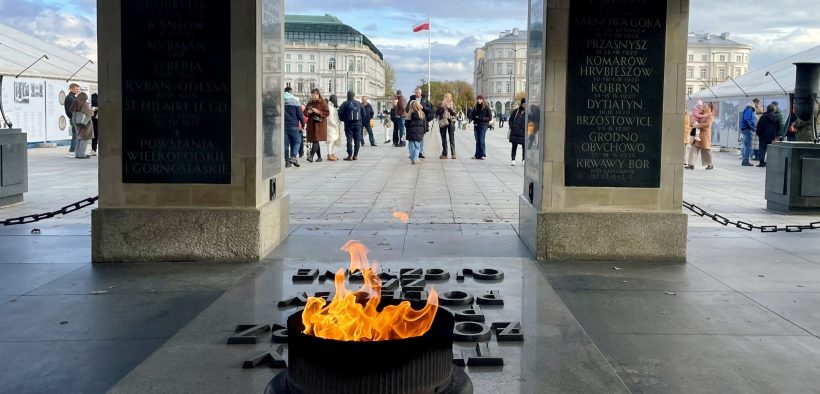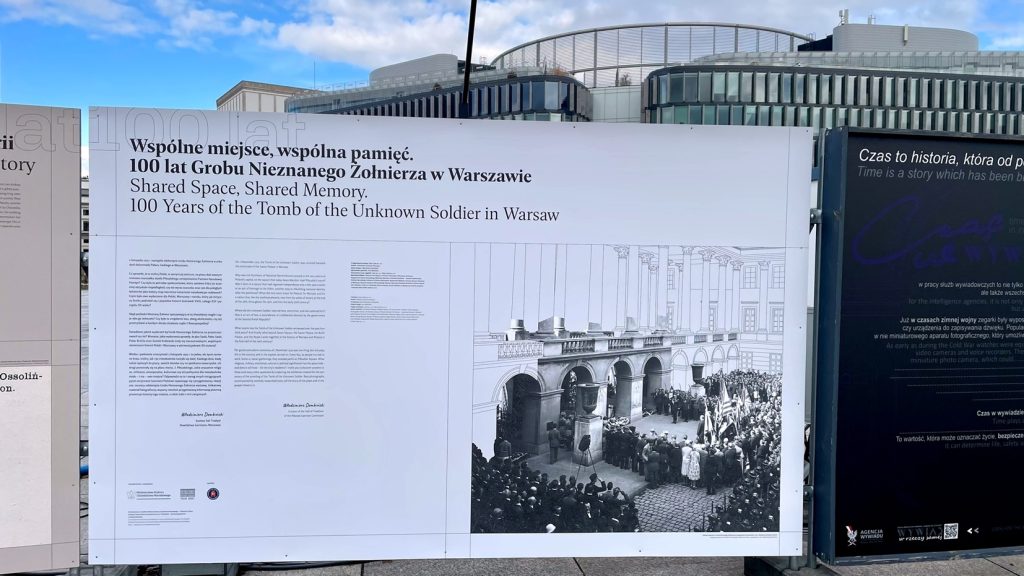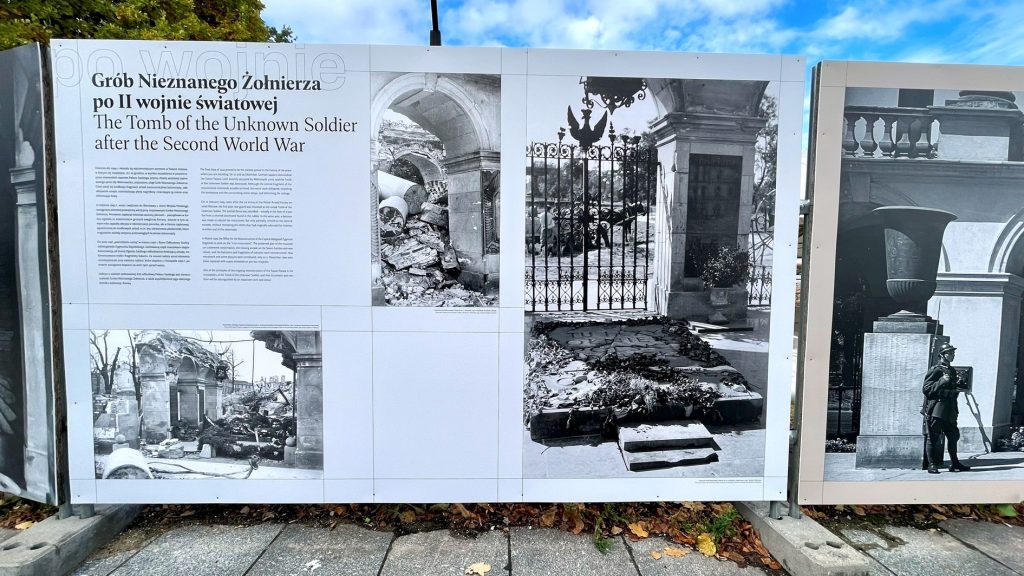The Tomb of the Unknown Soldier in Warsaw Turns 100
Share

This year marks the centenary of the Tomb of the Unknown Soldier in Warsaw — a national monument honoring all those who gave their lives in defense of Poland and whose identities remain unknown. While most Poles are deeply familiar with this symbol of sacrifice, the site itself holds many lesser-known stories. Here are some of them.
“Who are you? I do not know. Where is your family home? I do not know. Who are your parents? I do not know. Nor do I wish to know, nor shall I ever know — not until Judgment Day. Your greatness lies in the fact that you are unknown…” With these words, Father Antoni Szlagowski, later Auxiliary Bishop of Warsaw, opened his homily during the funeral of the Unknown Soldier on November 2, 1925, in St. John’s Archcathedral.
After the Mass, the coffin was carried in a solemn procession to Saxon Square (Plac Saski). A moment of silence fell over the gathered crowd, followed by artillery salutes and the laying of wreaths. President of the Republic of Poland Stanisław Wojciechowski then lit the Eternal Flame — a fire that continues to burn to this day.
The Mystery of the Young Hero from Lviv
Do we truly know nothing about the Unknown Soldier? In fact, we do know this much — he was a defender of Lviv, who fought for Poland’s independence in 1918. A simple inscription inside the Tomb of the Unknown Soldier reads: “On November 2, 1925, the remains of an Unknown Polish Soldier, brought from a battlefield near Lviv, chosen by lot, were laid to rest in this place.” The drawing took place at the Ministry of Military Affairs, where the Lviv battlefield was selected by lot from among 15 battle sites fought for Poland’s freedom.
The person asked to make the final choice of the remains was Jadwiga Zarugiewiczowa, whose son Konstanty was killed in the Polish–Bolshevik War of 1920 and whose body was never recovered. At the Cemetery of the Lviv Eaglets, she stood before three coffins containing the bodies of unknown heroes — and chose one. The fallen soldier held no military rank, but his maciejówka cap adorned with the Polish eagle revealed that he had been a volunteer. He had gunshot wounds to the head and leg. His age was estimated at fourteen.
On November 1, 1925, the coffin departed from Lviv by train for Warsaw. Along the route, hundreds of people gathered to pay tribute to the young soldier. It arrived in the capital the following day, on All Souls’ Day.
An Unknown Initiator, a Known Place
The idea of erecting a Tomb of the Unknown Soldier in Warsaw first emerged in 1919, shortly after Poland regained its independence. However, it was only the creation of the world’s first such tomb in Paris in 1920 that inspired concrete action in Poland.
The current location of the Tomb — on Piłsudski Square, formerly Saxon Square — was not an obvious choice at the time. Debates over where to build the monument continued for years without resolution. Then, in 1924, an unexpected event determined its fate. Behind the memorial to Prince Józef Poniatowski, which then stood before the colonnade of the Saxon Palace, someone placed a stone slab bearing the inscription: “Here lie the remains of an Unknown Soldier who fell for the Fatherland,” and laid flowers upon it.
This symbolic gesture by an unknown individual effectively designated the future site of the tomb and soon gained broad public approval. General Władysław Sikorski took charge of the organizing committee, and sculptor Stanisław Ostrowski was chosen as the designer. Only years later did it become known that this spontaneous act of commemoration had originated with the Union of Polish Associations, led by Count Adam Zamoyski.
Surviving the Warsaw Uprising
The Tomb of the Unknown Soldier underwent a “dramatic transformation” during the Second World War. Aware of its symbolic importance, the Germans blew up the Saxon Palace after the outbreak of the Warsaw Uprising. Only a small, three-arched section of the colonnade survived — the very part that today forms the central element of the Tomb.
Throughout the occupation and the Uprising, the Tomb became a powerful symbol of resistance and hope. Witnesses recall that, despite the risk of severe reprisals, the people of Warsaw and members of the underground army continued to care for and protect the site with deep reverence.
What did the Tomb look like before the war? The open-air exhibition “A Shared Place, a Shared Memory: 100 Years of the Tomb of the Unknown Soldier in Warsaw”, displayed beside the monument on Piłsudski Square, recalls its appearance before the Saxon Palace’s destruction and the emotions that accompanied its creation in 1925.


A Trace of All Who Fell for Poland
The Tomb serves as a symbolic resting place for all those who fell defending Poland, particularly for those whose graves have been lost or remain unknown. In 1925, soil from fourteen specific sites of national remembrance was placed in urns within the Tomb. The first urns contained earth from the battlefields of Lviv (1918–1919), the Polish–Bolshevik War of 1920, and the First World War, including the fields of Verdun and Sochaczew.
History added further tragic chapters. Plaques were installed and additional urns filled with soil were included from the battlefields of the September 1939 campaign (near Wizna, the Bzura River, and Westerplatte), battles fought outside Poland during the Second World War (Monte Cassino, Tobruk, Narvik), streets and squares where fighting took place during the Warsaw Uprising, graves in Katyn, and sites of extermination (Majdanek, Auschwitz-Birkenau).
Each urn is labeled and was placed during solemn ceremonies attended by state authorities, military representatives, and the families of the fallen.
Flame of Remembrance on the 100th Anniversary of the Tomb of the Unknown Soldier
The 100th anniversary of the unveiling of the Tomb of the Unknown Soldier — one of Poland’s most important symbols of national memory — falls on November 2, 2025. State ceremonies are planned to mark the occasion, with the participation of the highest authorities of the Republic of Poland, military representatives, clergy, and foreign delegations.
The celebrations will be accompanied by the “Flame of Remembrance” campaign, which honors local heroes — often unnamed — who rest in cemeteries in Poland and abroad. The campaign will run until November 30, 2025. More information is available on the websites of the Museum of Polish History and of the Ministry of Culture and National Heritage.
Family News Service
Photos: s. Amata J. Nowaszewska CSFN / Family News Service



